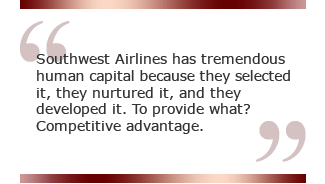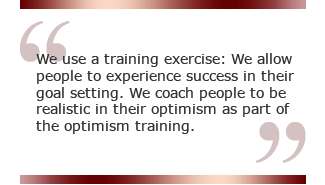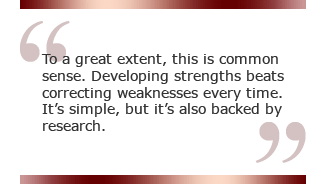Do you have any idea what you're worth to your company? Not your human capital -- no doubt you and your employer are well aware of your talents, experience, and education. Rather, can you estimate your value to your business in terms of the psychological capacity you possess that moves your organization to the outcomes it wants?
Well, probably not -- because very few people have inventoried their psychology, and even fewer know which attributes really propel business performance. Human capital has been studied and tested extensively, but psychological capital is such a new idea that few of us know whether we've got any or not.
 |
But if Fred Luthans has anything to say about it, that will all change.
Fred Luthans, Ph.D., is the George Holmes University Distinguished Professor of Management at the University of Nebraska-Lincoln. He has published about 150 articles and several books, served as the president of the National Academy of Management, is the co-editor-in-chief of the Journal of World Business, the editor for Organizational Dynamics and the Journal of Leadership and Organization Studies, is on the editorial board of several other journals, and is a fellow of the Academy of Management and the Decision Sciences Institute. Dr. Luthans says that, though management science and economics have explored business with excruciating thoroughness, they've overlooked something big -- the human mind.
An interest in the Positive Psychology movement got Dr. Luthans thinking about positive organizational behavior. Further research led him to a breakthrough: Hope, confidence, optimism, and resiliency make workers more productive.
This statement may seem like bedrock common sense to every great manager who reads it. However, Dr. Luthans' research takes it further than conventional wisdom. He's found that these attributes can be embedded, developed, measured, and trained to create sustainable, predictable, measurable increases over time. And that's not just common sense, that's profit.
Dr. Luthans has cowritten, with Carolyn Youssef and Bruce Avolio, a book about his findings: Psychological Capital: Developing the Human Competitive Edge (Oxford University Press, 2006). In this interview, he offers useful insights into psychological capital, including the business results of developing it, how managers can turn common sense into a systematic tool, and why psychological capital is a business advantage most organizations don't know they have.
GMJ: What's the difference between human capital and psychological capital?
Dr. Luthans: The starting point is that every business, as well as this business school, has been focused on financial capital. That's what our curriculum is based on, that's how our courses are taught, that's the mentality of most business managers today: How do we manage our financial and, to a degree, our physical capital? We've all been conditioned to think about return on investment.
But we finally realized that there was a significant differential between the book and market value of companies and the so-called worth of the company. That disparity was made up of human capital. Then some of the top business leaders were widely quoted as saying things like, "The value of my company walks out the door every night." They began to recognize that it wasn't just the financial or physical assets, but also their human assets, that made up the value of the company.
We'd always given lip service to that, but then we started looking for ways to show the value of human capital on a balance sheet. So the human resource management field took that concept of human capital and defined it in fairly standard ways that everyone would pretty much agree with today. They said that human capital is comprised of the education, experience, skills, and to a degree, the abilities of the people involved in any enterprise. So that all became known as human capital.
We all became excited about that because this was the competitive advantage. Everybody could purchase information technology, and everybody could buy the same type of equipment and develop the same marketing plans. What they couldn't buy as a commodity was their human capital.
GMJ: Can you give me an example?
Luthans: Southwest Airlines has tremendous human capital because they selected it, they nurtured it, and they developed it. To provide what? Competitive advantage.
Most U.S. airlines have the same airplanes, and they all have the same inventory control models, but they don't have the same human capital. That's why Southwest hasn't lost money when all the rest of them have. Psychological capital goes beyond human capital.
GMJ: What's psychological capital?
Luthans: Human capital is now more or less the state of the art. But I'm not satisfied with that. I think an understanding of human capital has advanced the competitive advantage of organizations, but I just didn't feel it was enough. Some of my colleagues are looking at social capital, such as the networks of relationships and friendships that are helpful to all businesses. But there's another layer -- the psychological capacity of the people in an organization.
 |
We define psychological capital, or "PsyCap" as we've started calling it, as an individual's positive psychological state of development that is characterized by four things: confidence, optimism, hope, and resiliency. Confidence means being able to take on and put in the necessary effort to succeed at challenging tasks. Optimism is making a positive attribution about succeeding now and in the future. Hope is persevering toward goals, and when necessary, redirecting paths to goals in order to succeed. Resiliency means the ability to sustain and bounce back from problems and adversity to attain success.
GMJ: Aren't these just personal characteristics, things everybody has and does?
Luthans: First, not everybody has these characteristics. Psychological capital is an underlying construct, a higher order core capacity that underlies capacities like confidence, hope, optimism, and resiliency. What we call psychological capital is made up of those four capacities, and together they predict performance outcomes more accurately than any one of them does.
Second, the definitions of psychological capital are quite precise, and that's something that I insist upon. I didn't want to make the same mistake that some writers have made, because they really didn't dig into the science of what they were saying -- they came out with things that just sounded good and had marketability but didn't have scientific backup. We have enough buzzwords and glitzy terms. What I wanted to do was put some science and a new name to a resource that's always been there.
So to be included as PsyCap, a given positive construct must meet some criteria. It must be based on theory, research, and valid measurement; it must be open to development; and it must have measurable performance impact.
GMJ: Why do you include confidence, optimism, hope, and resiliency, but not other constructs?
Luthans: Because those are the constructs that provide measurable business impact. For instance, let's look at self-efficacy or confidence. I conducted a meta-analysis with a former doctoral student of mine, and we found that there was a .38 correlation between self-efficacy and performance. This accounts for about 15% of the variance between a person's efficaciousness and performance.
That correlation is quite high compared to what we normally see in behavioral science. We did some exploratory correlational studies that indicated correlations in the .30 range for all four psychological capacities. We've done this in several industries, so we're able to show that there is a correlation between these capacities and performance.
The next step in our research is to show causal impact -- that these capacities can be developed and that they have performance impact when they are developed. But the key here is that it's based on theory and research, specifically on Albert Bandura's social cognitive theory, which is the best behavioral science theory there is.
GMJ: The ability to develop is one of your primary criteria. How can PsyCap be developed?
Luthans: Essentially, we use a training exercise: We allow people to experience success in their goal setting. We coach people to be realistic in their optimism as part of the optimism training. We show them how to set optimistic goals, then make positive attributions about why things went well and why things didn't go well. To increase resiliency, we use developmental literature to increase people's accurate assessments of why they are strong and what are their strong points.
We pack that all into a two-hour training program, which we developed based on our research and intervention studies. What we found in these intervention studies was that there was a statistically significant increase in the level of psychological capital.
GMJ: How long do these beneficial feelings last? You can learn to be hopeful in a training program, but will that apply in the real world? And if so, for how long?
Luthans: And of course, that's what we're trying to determine. We are moving away from a laboratory-type setting into field settings, such as in high-tech manufacturing, where we've validated most of this approach and have found similar results over time. But as for how long PsyCap lasts after training, we're saying months rather than years. We've measured the impact of this training two to three months afterward.
We're just starting this, and we haven't had the opportunity to check it over time. But in the studies and the relationships that we're building at our research sites, we're finding that "booster shots" help sustain the impact. So after subjects have gone through the initial two-hour training, we have them download exercises to do, including setting goals, determining pathways, experiencing success, getting persuasion from the facilitator, and looking at building up their assets for resiliency. We send out boosters every few weeks to maintain the impact. They're basically reminders: Are you still doing your goal setting? Are you still determining contingency plans for how you're going to accomplish your goals?
We're also showing that PsyCap does hold up in the real world. Most of our laboratory studies were done using student subjects, but as we try them in the real world, we're finding very similar results, both across organizations as well as within specific organizations.
The important question is, does that development impact performance? The answer is yes. We are able to show through multiple measures of performance that this training does have an impact on individual performance outcomes.
GMJ: Dr. Luthans, people are going to read this and think that helping people to be hopeful, optimistic, resilient, confident -- that's all stuff good managers do every day. It's what parents do every day.
 |
Luthans: Correct.
GMJ: It's conventional wisdom.
Luthans: Correct.
GMJ: So what's the difference between what you're researching and basic management?
Luthans: It's different because we're using clinical definitions of common words, and those definitions aren't the same as the common terminology. What I mean by hope is what Positive Psychology means by hope. I'm citing those references, and I'm developing that theory, and I measure it a certain way. What good managers do every day leads to good performance results, but not necessarily to sustainable, predictable, measurable increases over time.
But you're right: To a great extent, this is common sense. It's as simple as being positive rather than negative. Developing strengths beats correcting weaknesses every time. It's simple, but it's also backed by research.
We know in our heart of hearts that this theory is correct. We know in our gut that it's much more effective to give people positive feedback rather than negative feedback. We know in our gut that it's much more effective in how we raise our children. But the key here is that we have to show impact, and that's what we're trying to do. We're not trying to make a buzzword out of this. We're trying to show that there's science to this, and it has impact.
GMJ: What can managers do to increase PsyCap in their employees or their workgroups?
Luthans: First, managers need self-awareness; they need to increase their own efficacy, optimism, hope, and resilience by examining their own behavior. Think about how you typically handle a given situation, then plan ahead to behave differently, if necessary.
It's good to note your positive and negative responses to employees. Aim for three to five positives for every negative. You'll notice a change in the way people interact with you pretty soon. There's a lot of research that documents that positive-to-negative ratio. (See "Be Nice: It's Good for Business" and "The Impact of Positive Leadership" in the "See Also" area on this page.)
Also, let people experience success. Just saying "Good job!" isn't enough -- people need specifics and details. Then leverage that success into more, adding milestones. (See "The Best Ways to Recognize Employees" in the "See Also" area on this page.)
Setting goals increases hope and efficacy too. If employees have trouble reaching a goal, help them discover alternate resources and alternative methods, because that builds not only hope, but also resiliency.
GMJ: You've done follow-up studies. What are the performance results?
Luthans: In the last phase of our research, we're calculating the return on investment. In one calculation, we put 75 engineering managers at a very well-known high-tech firm through PsyCap training. We saw the impact that it had on their performance outcomes, and we translated that through utility analysis. Then we subtracted the cost of that training and the engineers' time. The return on investment in psychological capital was 270%.
GMJ: That beats my mutual fund.
Luthans: Yours and everyone else's.
-- Interviewed by Jennifer Robison